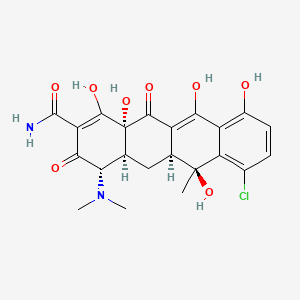| MeSH term | MeSH ID | Detail |
|---|---|---|
| Blood Platelet Disorders | D001791 | 12 associated lipids |
| Escherichia coli Infections | D004927 | 17 associated lipids |
| Pasteurella Infections | D010326 | 8 associated lipids |
| Swine Diseases | D013553 | 16 associated lipids |
| Poultry Diseases | D011201 | 21 associated lipids |
| Lymphadenitis | D008199 | 8 associated lipids |
| Skin Diseases, Infectious | D012874 | 7 associated lipids |
| Subacute Sclerosing Panencephalitis | D013344 | 3 associated lipids |
| Synovitis | D013585 | 15 associated lipids |
| Campylobacter Infections | D002169 | 13 associated lipids |
chlortetracycline
chlortetracycline is a lipid of Polyketides (PK) class. Chlortetracycline is associated with abnormalities such as Granulomatous Disease, Chronic, Infection, Ischemia, Cerebral Ischemia and Cerebral Infarction. The involved functions are known as Regulation, Binding (Molecular Function), Agent, Stimulus and Process. Chlortetracycline often locates in Protoplasm, Plasma membrane, Membrane, Cytoplasm and specific granule. The associated genes with chlortetracycline are FPR1 gene, P4HTM gene, Homologous Gene, HIST1H1C gene and Microbiome. The related lipids are Lysophosphatidylcholines, Sterols, dilauroyl lecithin, seminolipid and Total cholesterol. The related experimental models are Mouse Model.
Cross Reference
Introduction
To understand associated biological information of chlortetracycline, we collected biological information of abnormalities, associated pathways, cellular/molecular locations, biological functions, related genes/proteins, lipids and common seen animal/experimental models with organized paragraphs from literatures.
What diseases are associated with chlortetracycline?
chlortetracycline is suspected in Ischemia, Cerebral Ischemia, Cerebral Infarction, Granulomatous Disease, Chronic, Infection, Antibiotic resistant infection and other diseases in descending order of the highest number of associated sentences.
Related references are mostly published in these journals:
| Disease | Cross reference | Weighted score | Related literature |
|---|
Possible diseases from mapped MeSH terms on references
We collected disease MeSH terms mapped to the references associated with chlortetracycline
PubChem Associated disorders and diseases
What pathways are associated with chlortetracycline
There are no associated biomedical information in the current reference collection.
PubChem Biomolecular Interactions and Pathways
Link to PubChem Biomolecular Interactions and PathwaysWhat cellular locations are associated with chlortetracycline?
Visualization in cellular structure
Associated locations are in red color. Not associated locations are in black.
Related references are published most in these journals:
| Location | Cross reference | Weighted score | Related literatures |
|---|
What functions are associated with chlortetracycline?
Related references are published most in these journals:
| Function | Cross reference | Weighted score | Related literatures |
|---|
What lipids are associated with chlortetracycline?
Related references are published most in these journals:
| Lipid concept | Cross reference | Weighted score | Related literatures |
|---|
What genes are associated with chlortetracycline?
Related references are published most in these journals:
| Gene | Cross reference | Weighted score | Related literatures |
|---|
What common seen animal models are associated with chlortetracycline?
Mouse Model
Mouse Model are used in the study 'Chlortetracycline and demeclocycline inhibit calpains and protect mouse neurons against glutamate toxicity and cerebral ischemia.' (Jiang SX et al., 2005).
Related references are published most in these journals:
| Model | Cross reference | Weighted score | Related literatures |
|---|
NCBI Entrez Crosslinks
All references with chlortetracycline
Download all related citations| Authors | Title | Published | Journal | PubMed Link |
|---|---|---|---|---|
| DomaradskiÄ IV | [Iridescent phenomenon in Pseudomonas aeruginosa]. | 1975 | Zh. Mikrobiol. Epidemiol. Immunobiol. | pmid:808057 |
| Ankirskaia AS | [The resistance of dysentery bacilli to antibiotics]. | 1965 | Zh. Mikrobiol. Epidemiol. Immunobiol. | pmid:5337069 |
| Trofimov AM | [Experience with the use of Ploskirev's medium with the addition of biomycin in studies on dysentery]. | 1968 | Zh. Mikrobiol. Epidemiol. Immunobiol. | pmid:5731537 |
| Mordvinova NB and Rogunova KA | [The properties of pathogenic staphylococci isolated from healthy children]. | 1967 | Zh. Mikrobiol. Epidemiol. Immunobiol. | pmid:5187238 |
| Shenderov BA and Shcherbakov AA | [The interaction between tetracycline and Escherichia coli]. | 1973 | Zh. Mikrobiol. Epidemiol. Immunobiol. | pmid:4595603 |
| TOROSOV TM et al. | [THE RESULTS OF BACTERIOLOGICAL EXAMINATION OF THE BILE IN DYSENTERY PATIENTS]. | 1963 | Zh. Mikrobiol. Epidemiol. Immunobiol. | pmid:14151746 |
| KOKHANOVSKAIA TM and POPOVA GO | [ANTIOBIOGRAMS OF TYPHOID BACILLI. II. THE COMBINED ACTION OF ANTIBIOTICS ON FRESHLY ISOLATED TYPHOID BACILLUS STRAINS]. | 1963 | Zh. Mikrobiol. Epidemiol. Immunobiol. | pmid:14151772 |
| FAERMAN NN | [The use of biomycin in the treatment of patients with pharyngeal diphtheria]. | 1960 | Zh. Mikrobiol. Epidemiol. Immunobiol. | pmid:13697864 |
| SAVITSKAIA EP and ZUBOK LP | [Studies on the mechanism of action of biomycin and sekazin on Rickettsia prowazekii]. | 1961 | Zh. Mikrobiol. Epidemiol. Immunobiol. | pmid:13746918 |
| LI K | [The effect of chemotherapy on immunogenesis in experimental typhoid fever and dysentery infection. Part I. The effect of antibiotics on immunogenesis in experimental typhoid fever infection]. | 1960 | Zh. Mikrobiol. Epidemiol. Immunobiol. | pmid:14416635 |
